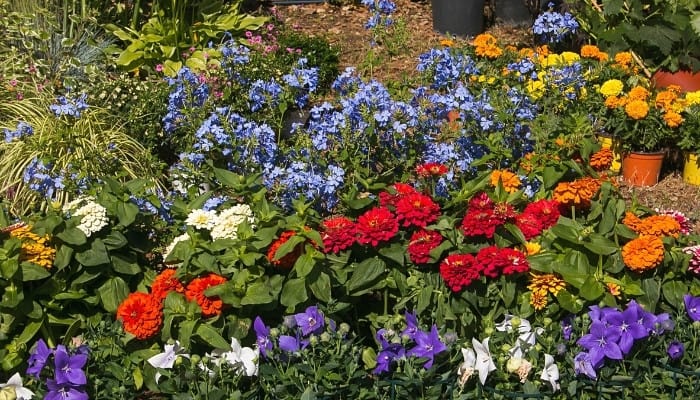Surprisingly, a significant number of beloved flowers have origins in Italy. One such example is the rose, which is the official flower of Italy.
If you’re looking to add a romantic flair to your garden reminiscent of Italy, you’ve come to the right place. Enjoy scrolling through the following 25 traditional flowers of Italy.
#1. Roses
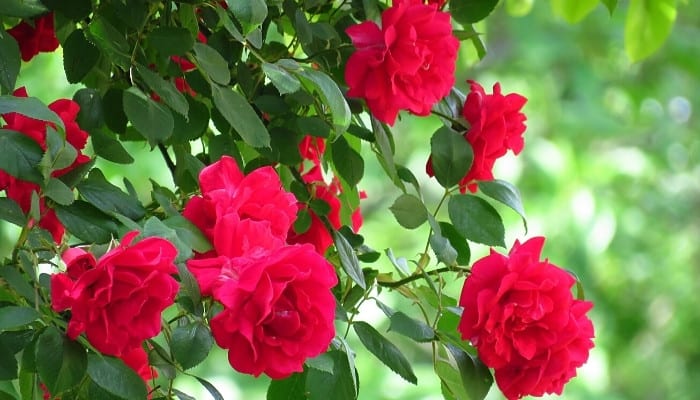
The rose belongs to the genus Rosa, with over 300 species and more than 10,000 cultivars. Most roses are bushes, but many are climbing or trailing species.
The origins of various roses are found around the world, mainly in Asia, Europe, Africa, and North America.
They come in different sizes including miniature, standard, and climbers that reach up to 7 meters tall.
- Botanical Name: Rosa
- Meaning: Love, gratitude, romance, and admiration
- Common Colors: Red, pink, white, yellow, and orange
- Popular Varieties: English, climbing, and miniature
- Best for Growing Zones: 3 to 5
- Light Requirements: 6 hours or more
#2. Sunflowers
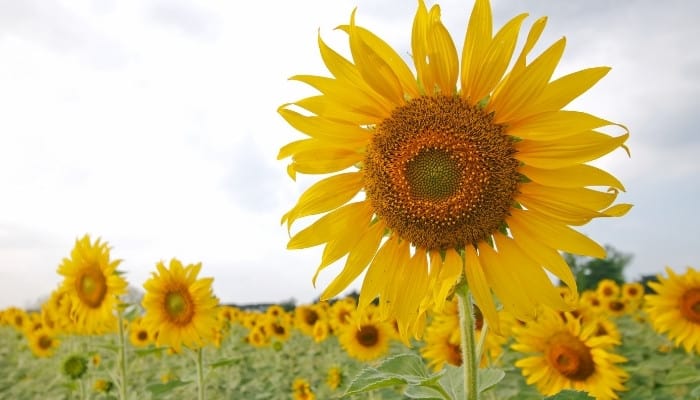
Helianthus, more commonly known as sunflowers, are a large variety of daisies that hail from North America, Central America, and South America.
The name “sunflower” derives from the fact that the flowers resemble the celestial Sun in the sky. Sunflowers are used for decoration as well as for harvesting their seeds.
- Botanical Name: Helianthus
- Meaning: Happiness, honesty, peace, and devotion
- Common Colors: Yellow, orange, red, and brown
- Popular Varieties: Common, giant, slender
- Best for Growing Zones: 2 to 11
- Light Requirements: 6 to 8 hours
#3. Lilies
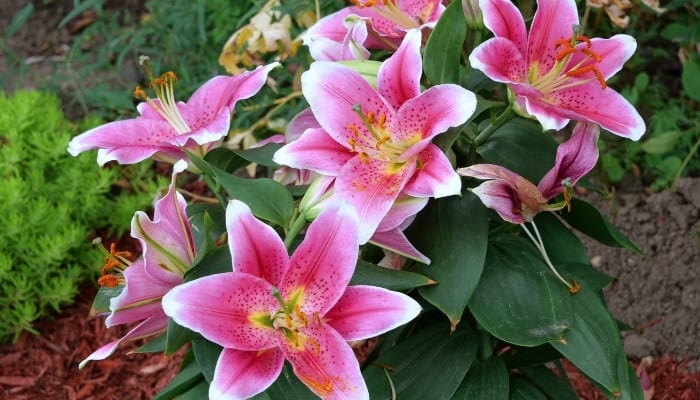
Lilies are one of the most preferred perennial flowers that grow back each year from bulbs. They are one of the most important flowers in culture, history, and literature.
They range in color, though come mainly in light hues, and may grow anywhere from 2 to 6 feet tall.
Many flowers with “Lily” in the name are not actually lilies at all, so check for the name Lilium on any of lilies you purchase.
- Botanical Name: Lilium
- Meaning: Fertility, purity, and love
- Common Colors: White, pink, yellow, and orange
- Popular Varieties: Trumpet, Oriental, and Asiatic
- Best for Growing Zones: 3 to 11
- Light Requirements: Full sun, part sun, partial shade
#4. Orchids
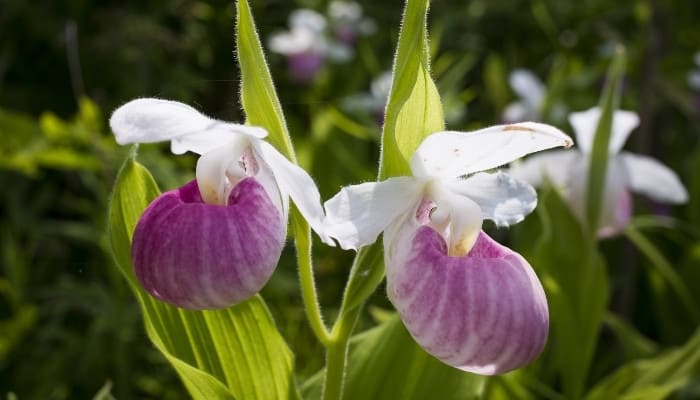
The Orchidaceae family consists of thousands of species (over 28,000) and over 760 genera. There are over 100,000 cultivars that belong to the various species.
They are one of the largest families of flowers in the world. Accordingly, orchids range greatly in size, color, and even petal shape.
- Botanical Name: Orchidaceae
- Meaning: Beauty, love, and luxury
- Common Colors: White, blue, pink, red, yellow, orange, and green
- Popular Varieties: Cattleya, Dendrobium, and Oncidium
- Best for Growing Zones: 6 to 9
- Light Requirements: Bright but indirect light
#5. Chrysanthemums
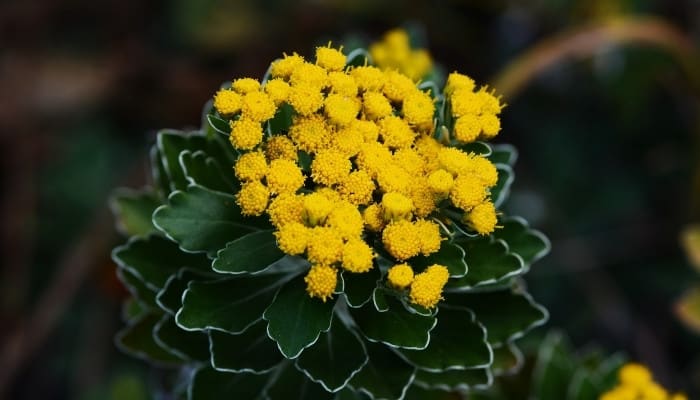
Chrysanthemums, also called chrysanths and mums, are part of the genus Chrysanthemum in the flowering plant family of Asteraceae.
Most chrysanthemums originate from Asia and Europe, though they have since then spread around the world. This pretty Italian flower is found in gardens that receive at least partial full fun.
- Botanical Name: Chrysanthemum
- Meaning: Life, gifts, rebirth
- Common Colors: Yellow, white, red, lavender, purple, and orange
- Popular Varieties: Single blooms, spider blooms, and quilled blooms
- Best for Growing Zones: 5 to 9
- Light Requirements: 6 to 8 hours
#6. Mimosa

The Mimosa genus consists of approximately 400 species, all within the Fabaceae family of legumes. The flower finds its name in the root of the Greek word mimos which means “mimic.”
The flower has two species that stand out more than others: the Mimosa pudica (also called touch-me-not) and the Mimosa tenuiflora (which contains dimethyltryptamine), which is used in the world-renowned psychedelic brew ayahuasca.
- Botanical Name: Mimosa
- Meaning: Love, the sun
- Common Colors: Yellow
- Popular Varieties: Silk, catclaw, and lollipop
- Best for Growing Zones: 6 to 9
- Light Requirements: Bright but indirect light
#7. Peonies
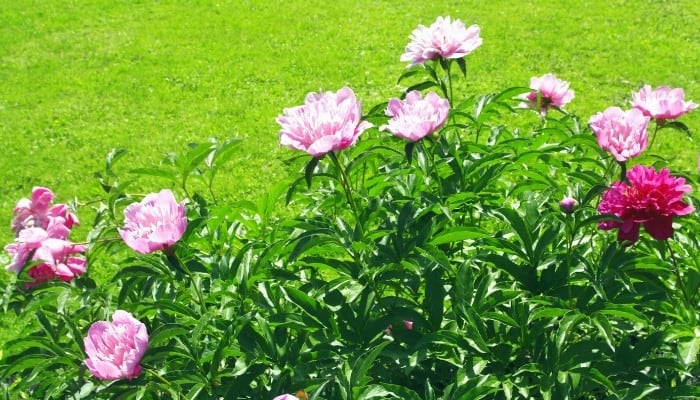
Peonies are lovely Italian flowers that grow in most climate zones and come in an abundance of colors (though most have a reddish or pinkish hue).
The peony is the only genus in the Paoniaceae family of flowering plants. There are nearly 40 distinguishable species, though the exact number is not certain.
- Botanical Name: Paeonia
- Meaning: Love, happiness, beauty, wealth, and romance
- Common Colors: Rose, red, pink, and white
- Popular Varieties: ‘Coral Charm’, ‘Shirley Temple’, and ‘Sorbet’
- Best for Growing Zones: 2 to 8
- Light Requirements: 8 hours
#8. Carnations
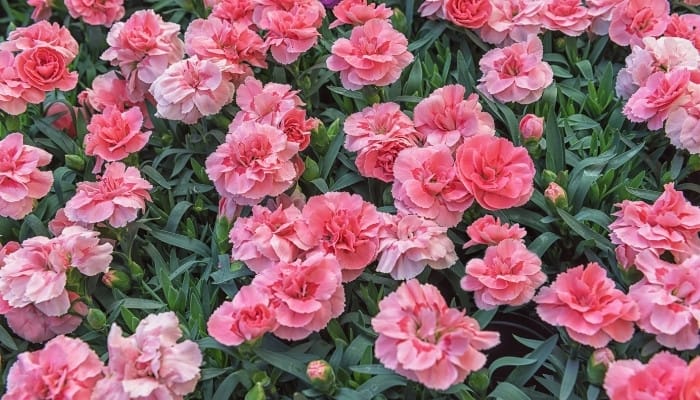
Carnations are one of the best-known flowers that represent love. In fact, most of our parents and grandparents were much more familiar with the carnation.
They were often pinned to blouses during dances, weddings, and other romantic/special occasions.
- Botanical Name: Dianthus caryophyllus
- Meaning: Love, protection, healing, and fascination
- Common Colors: Yellow, white, pink, scarlet, and red
- Popular Varieties: Dianthus caryophyllus, Dianthus deltoides, bicolor, and Dianthus plumarius
- Best for Growing Zones: 5 to 9
- Light Requirements: 6 hours or more
#9. Poppies
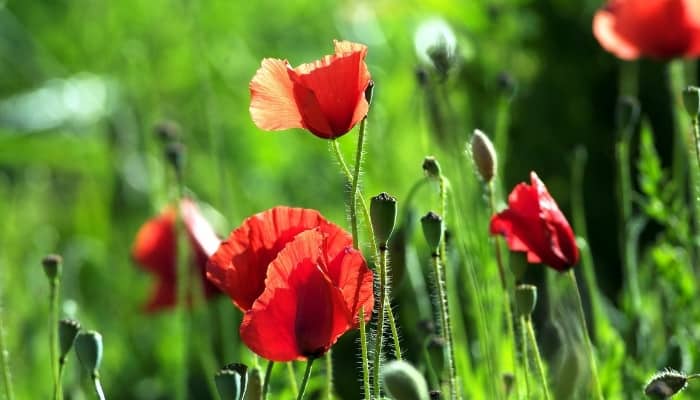
Poppies are another of the Italian flowers that you may have not guessed were Italian.
Papaver, as they are scientifically known, come in a wide variety of colors, require a decent amount of sunlight, and signify resurrection after death (rebirth) and endurance.
- Botanical Name: Papaver
- Meaning: Endurance and resurrection
- Common Colors: White, pink, white, red, orange, and purple
- Popular Varieties: Corn, Oriental, opium, and California
- Best for Growing Zones: 5 to 7
- Light Requirements: 6 hours or more
#10. Buttercups
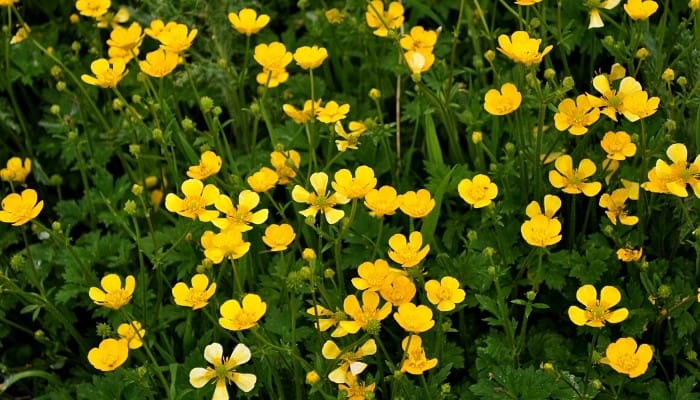
Buttercups are another flower that is enjoyed by gardeners and flower fans around the world, though their name may be elusive.
Often mistaken for dandelions and other yellow flowers, buttercups are larger and much more colorful than these so-called look-alikes.
Buttercups are most often orange-red or pinkish colors, though yellow is common too.
- Botanical Name: Ranunculus
- Meaning: Purity, happiness, friendship, and youth
- Common Colors: Orange, red, and pink
- Popular Varieties: Bulbous buttercup, early buttercup, and meadow buttercup
- Best for Growing Zones: 8 to 10
- Light Requirements: Full sun to partial shade
#11. Sweet Pea
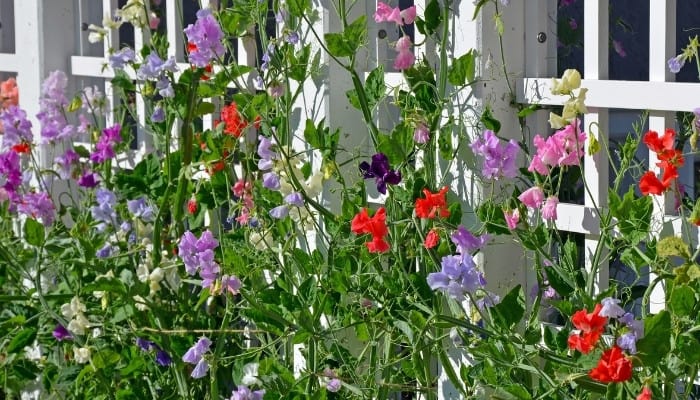
Sweet pea comes in a diverse range of colors, including blue, purple, lavender, and red or pink. They grow well in most temperate climates but need as much full sun as possible in order to thrive.
The symbolism behind sweet peas is reminiscent of its name – love, adoration, and attraction (just as you feel about your sweetheart).
- Botanical Name: Lathyrus odoratus
- Meaning: Love, attraction, and adoration
- Common Colors: Pink, red, lavender, purple, and blue
- Popular Varieties: ‘Fire and Ice’, ‘Prima Ballerina’, and ‘Pandemonium’
- Best for Growing Zones: 2 to 9
- Light Requirements: Full sun
#12. Oleander
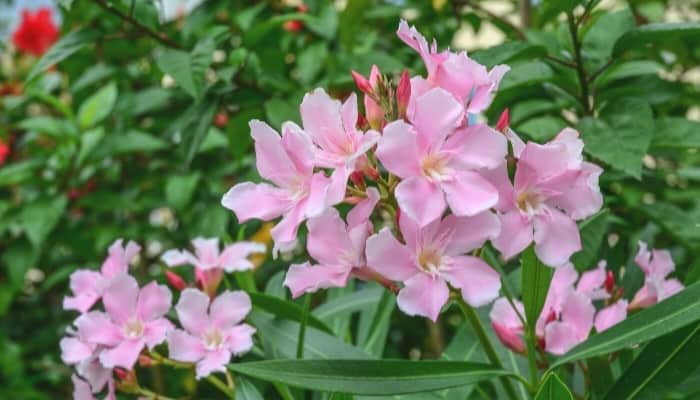
Oleanders are another flower that signifies love and relationships as well as being available in a plethora of colors ranging from white and off-yellow to salmon and burgundy.
That said, you may find them harder to grow in zones that get rather hot or cold.
- Botanical Name: Nerium oleander
- Meaning: Love and relationships
- Common Colors: White, off-white, yellow, pink, salmon, red, and burgundy
- Popular Varieties: ‘Apple Blossom’, ‘Calypso’, red, and ‘Twist of Pink’
- Best for Growing Zones: 8 to 10
- Light Requirements: Full sun
#13. Daffodils & Jonquils

Daffodils and jonquils represent love, friendship, and desire. They are most often found in white and yellow colors and grow well in full sun with a bit of shade.
They do well in most climates, aside from regions that receive lots of extreme heat and/or cold weather.
- Botanical Name: Narcissus jonquilla
- Meaning: Friendship, love, and desire
- Common Colors: Yellow and white
- Popular Varieties: Yellow trumpet daffodils
- Best for Growing Zones: 3 to 8
- Light Requirements: Full sun to partial shade
#14. Geraniums
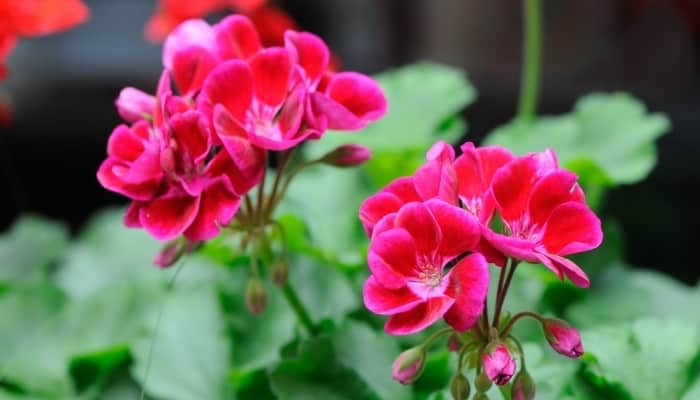
Geraniums, known scientifically as Pelargonium, come in numerous colors, including pinks, purples, reds, whites, and more. They love growing in climates that stay warm and get lots of sun.
The flowers are easy to grow and take little time or effort to maintain, making them perfect for gardens and for around the home (hanging baskets anyone?).
- Botanical Name: Pelargonium
- Meaning: Good health, good wishes, and happiness
- Common Colors: White, pink, red, purple, and lilac
- Popular Varieties: Red, ivy, regal, and zonal
- Best for Growing Zones: 9 to 12
- Light Requirements: 4 to 6 hours
#15. Dahlias

Dahlias are a type of flower belonging to the Asteraceae family that grow from tuberous roots and will grow back each year (if you live in a warm enough climate).
There are at least 42 species of dahlias and well over 20,000 cultivars that are known. They are closely related to sunflowers and daisies.
- Botanical Name: Dahlia
- Meaning: Elegance, commitment, and wealth
- Common Colors: Red, yellow, orange, and pink
- Popular Varieties: ‘Arabian Nights’, ‘Rothesay Reveller’, and ‘Julie One’
- Best for Growing Zones: 8 to 10 (3 to 7 as well, but only for annual use)
- Light Requirements: 6 to 8 hours
#16. Marguerite Daisies
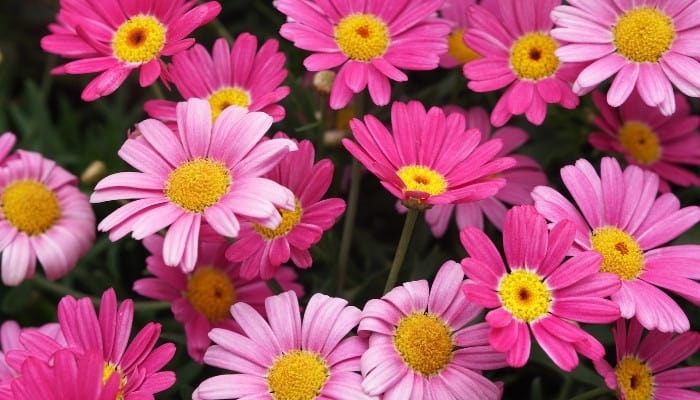
Marguerite daisies, known scientifically as Argyranthemum frutescens, are known for their light but vibrant colors as well as the patterns of their petals.
They resemble the famous daisy but come in many colors aside from white and yellow.
They grow best in warmer climates but can handle a bit of chilly temperature each year. Marguerite daisies require full sun or partial shade with lots of bright light.
- Botanical Name: Argyranthemum frutescens
- Meaning: Prosperity and wealth
- Common Colors: Yellow, white, and pink
- Popular Varieties: Golden marguerite, oxeye daisy, ‘Lipstick’, and mini marguerite
- Best for Growing Zones: 9 to 11
- Light Requirements: 6 hours or more
#17. Bougainvillea
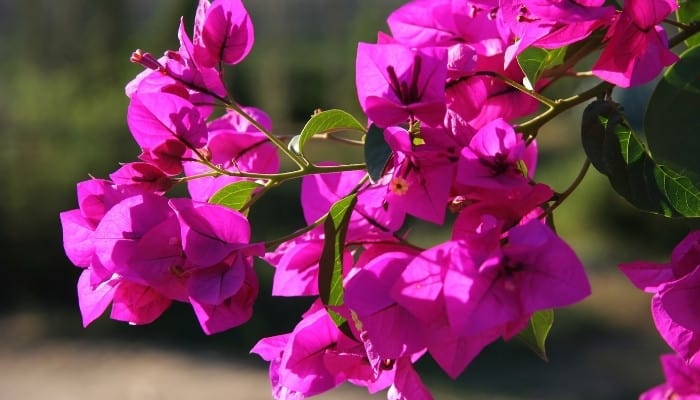
Bougainvillea is a fast-growing flower that loves warm climates and lots of sun.
Technically this flower will grow in less than full sun, but they truly thrive only if established in an area that receives 6 or more hours of full sun every day.
They come in various colors ranging from orange-red to pinks, purples, whites, and yellows.
- Botanical Name: Bougainvillea
- Meaning: Beauty and peace
- Common Colors: White, pink, purple, orange, and yellow
- Popular Varieties: Thorn bougainvillea and tree bougainvillea
- Best for Growing Zones: 9 to 10
- Light Requirements: 6 hours or more
#18. Spring Gentians
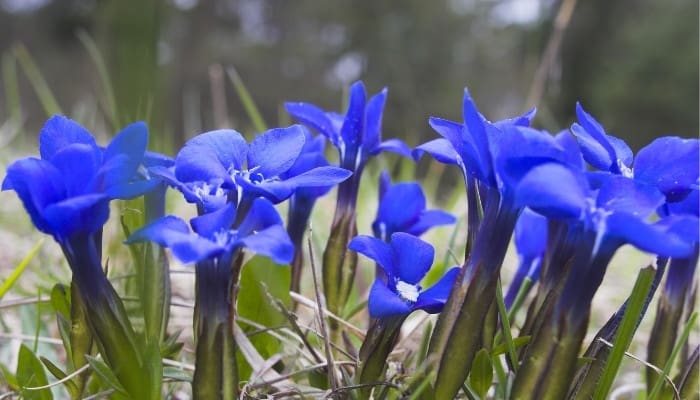
Spring gentians, or Gentiana verna as it is known scientifically, stand for justice and victory. They grow in most climates that aren’t barren ice land or harsh deserts.
The flower comes in one color, which is a vivid blue. They are sensitive to light but require quite a bit of it (just indirectly).
- Botanical Name: Gentiana verna
- Meaning: Victory, justice, and order
- Common Colors: Blue
- Popular Varieties: Gentiana verna
- Best for Growing Zones: 3 to 9
- Light Requirements: Partial shade
#19. Periwinkles
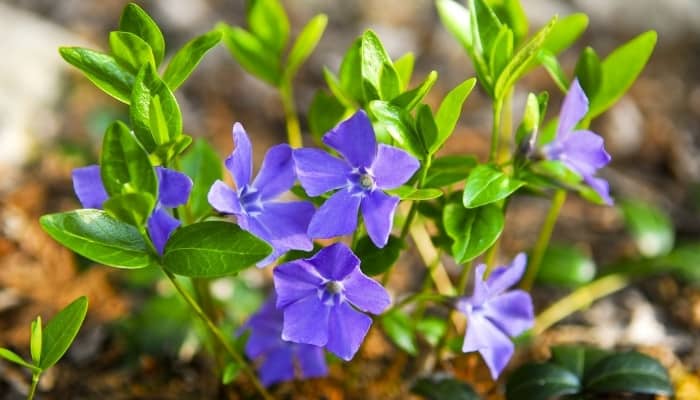
Periwinkles are another of the Italian flowers that would make a great touch to your garden (or windowsill). The flowers come in all shades of colors, minus reds, browns, and greens.
They grow in the most moderate tempered regions.
- Botanical Name: Catharanthus roseus
- Meaning: Calmness, winter, and serenity
- Common Colors: White, and various shades of pink, blue, and purple
- Popular Varieties: ‘Alba’, ‘Bowles’, ‘Flore Pleno’, and ‘Alboplena’
- Best for Growing Zones: 4 to 9
- Light Requirements: Full sun to partial shade
#20. Violets

Violets are not just blue, despite what the famous “roses are red, violets are blue” line might claim.
Violets also come in pinks, reds, greens, purples, whites, and just about any color you can imagine really. They grow in most regions that aren’t covered in ice, snow, or sand.
- Botanical Name: Viola
- Meaning: Modesty, resurrection, and death
- Common Colors: White, pink, blue, purple, red, yellow, and green
- Popular Varieties: Common blue violet, common dog violet, healthy dog violet, and ‘Alpine’
- Best for Growing Zones: 3 to 9
- Light Requirements: Lots of indirect light
#21. Cyclamen

Cyclamen is another of the flowers you may not be familiar with from this list of Italian flowers to add to your garden.
They are white, red, purplish and pinkish and grow only in zone number 5 (without issues). They require lots of light and make great houseplants for window baskets and flowerboxes.
- Botanical Name: Cyclamen
- Meaning: Love, adoration, devotion
- Common Colors: White, pink, lavender, and red
- Popular Varieties: alpinum, creticum, libanoticum, and repandum
- Best for Growing Zones: 5
- Light Requirements: Lots of bright but indirect light
#22. Asters
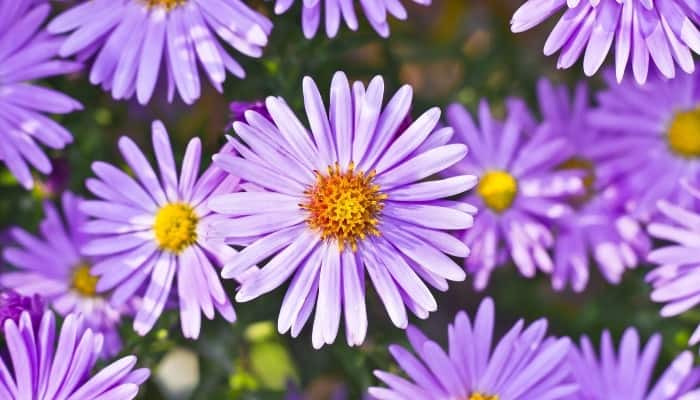
Asters, meaning stars, are just that – little purple and lilac-colored star-shaped flowers.
They represent love and faith, among other things, and grow well in most regions that don’t freeze or get into the 100°F+ temperature ranges.
- Botanical Name: Aster
- Meaning: Love, faith, and wisdom
- Common Colors: Lilac and purple
- Popular Varieties: ‘Grunder’, ‘Purple Dome’, ‘Fellowship’, and ‘Calico’
- Best for Growing Zones: 3 to 8
- Light Requirements: Full sun
#23. Forget-Me-Nots

Forget-me-nots are perhaps one of the most romantic flowers on our list. The mere name beckons romantic thoughts of someone you’d not like to ever forget.
They grow in most moderate temperature zones and are available in a wide variety of pink, purple, and blue shades as well as lighter colors like white.
- Botanical Name: Myosotis
- Meaning: Love, respect, and truth
- Common Colors: White, pink, pale purple, and various blue shades
- Popular Varieties: ‘Woodland’, ‘Victoria’, ‘Alpine’, ‘Early’, and ‘Strict’
- Best for Growing Zones: 5 to 9
- Light Requirements: Full sun to partial shade
#24. Edelweiss

Edelweiss is one of those flowers with a really strange name and an even stranger appearance. Somehow, in all of its strangeness, there is much beauty to be found.
The flower is white and off-white with a cluster of buds in the center. They grow well in most climates that don’t reach freezing levels.
- Botanical Name: Leontopodium nivale
- Meaning: Purity, love, innocence
- Common Colors: White and off-white
- Popular Varieties: Wild edelweiss
- Best for Growing Zones: 4 to 7
- Light Requirements: Full sun
#25. Cornflower
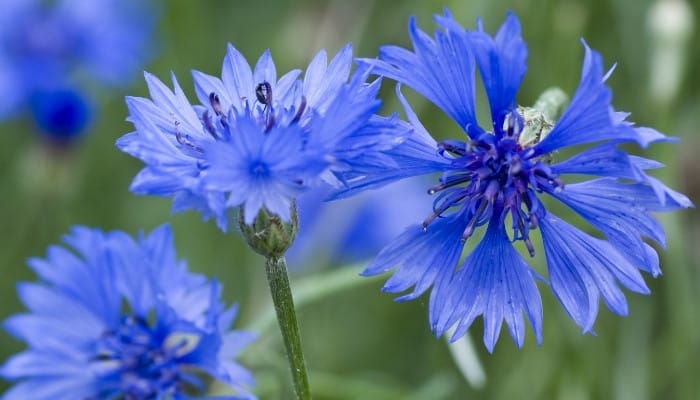
The cornflower has one of the plainest names of all flowers, though its scientific name, Centaurea cyanus, does indeed have a ring to it.
The flower stands for positive thoughts and hope. It is available in many colors, ranging from crimson to purple to white and pink. They grow almost anywhere (with full sun).
- Botanical Name: Centaurea cyanus
- Meaning: Hope and positivity
- Common Colors: Purple, pink, white, blue, and red
- Popular Varieties: ‘Blue Diadem’, classic, and ‘Jubilee Gem’
- Best for Growing Zones: 2 to 11
- Light Requirements: Full sun
Which Traditional Italian Flowers Are Best For Your Garden?
Out of the 25 traditional Italian flowers listed above, you should have no problem finding one (or two, or three, or four…) to add to your home or garden!
With all of the information provided, you’ll be able to quickly find which flower best suit your climate zone, garden, and personality!

